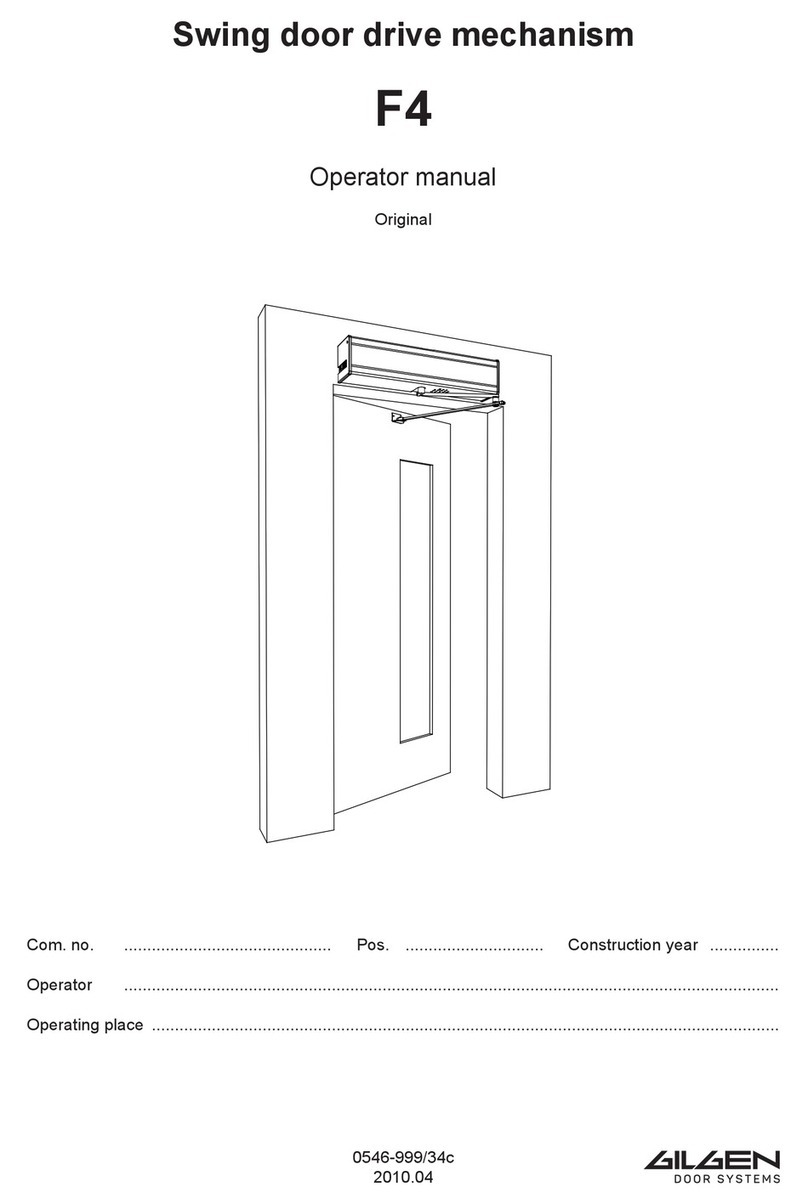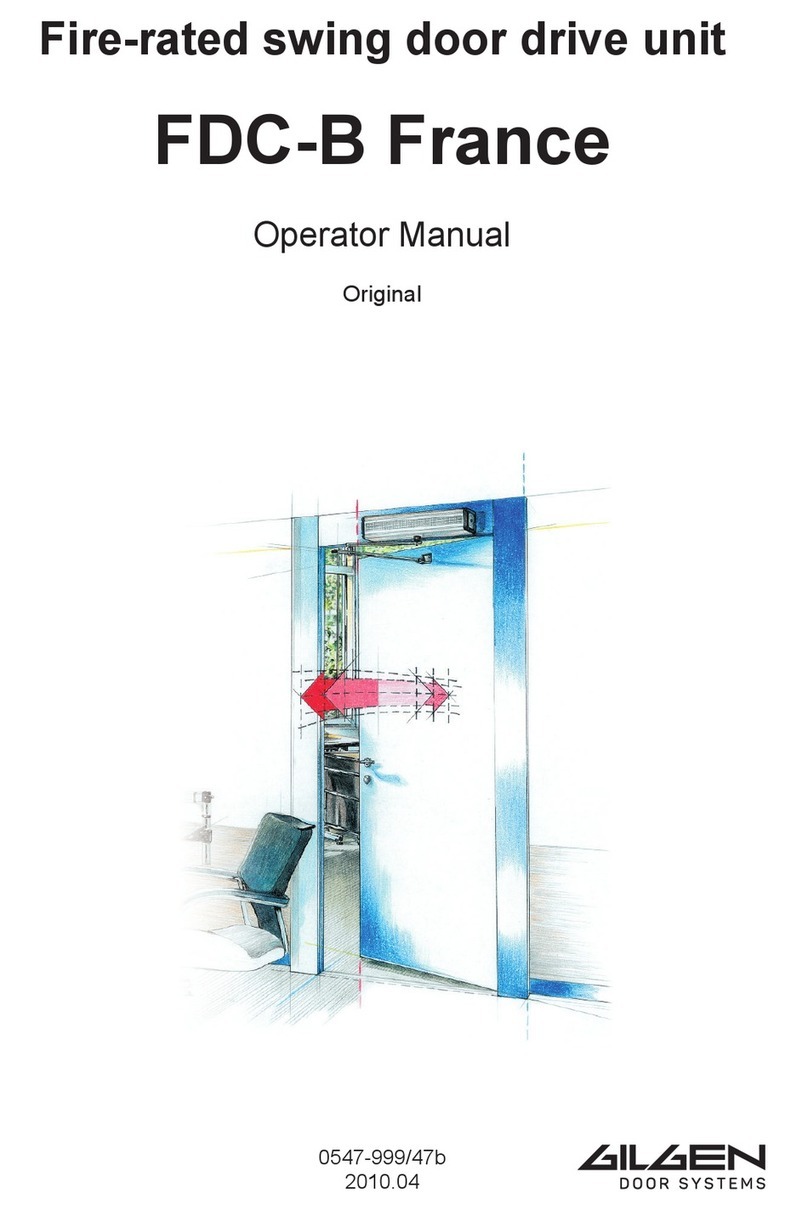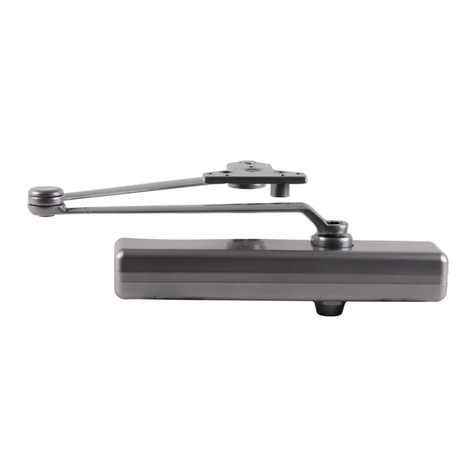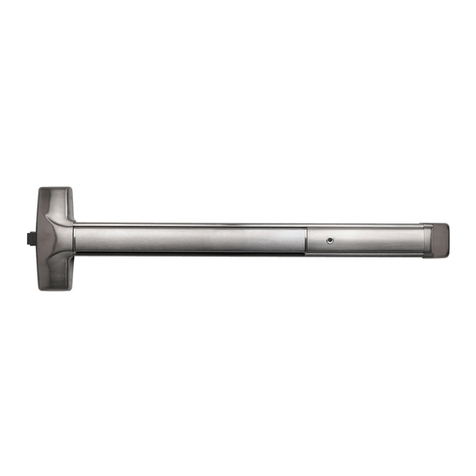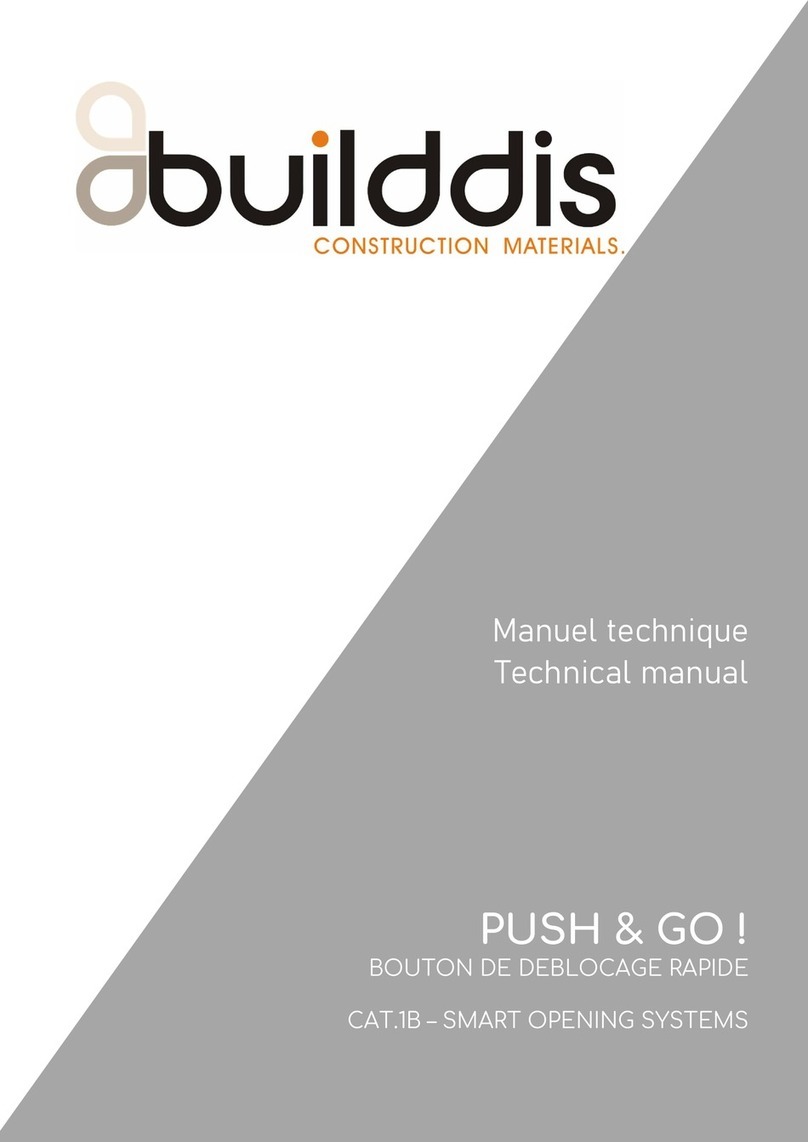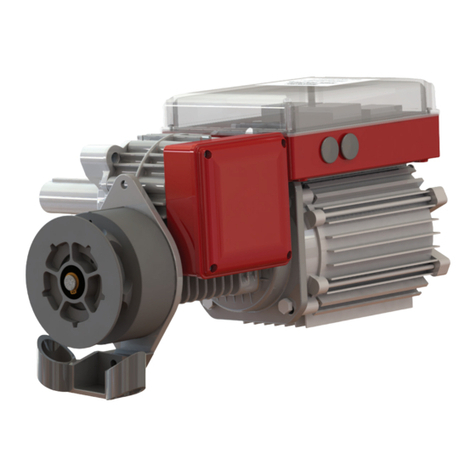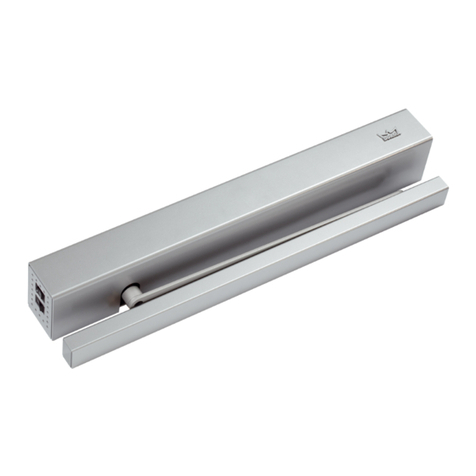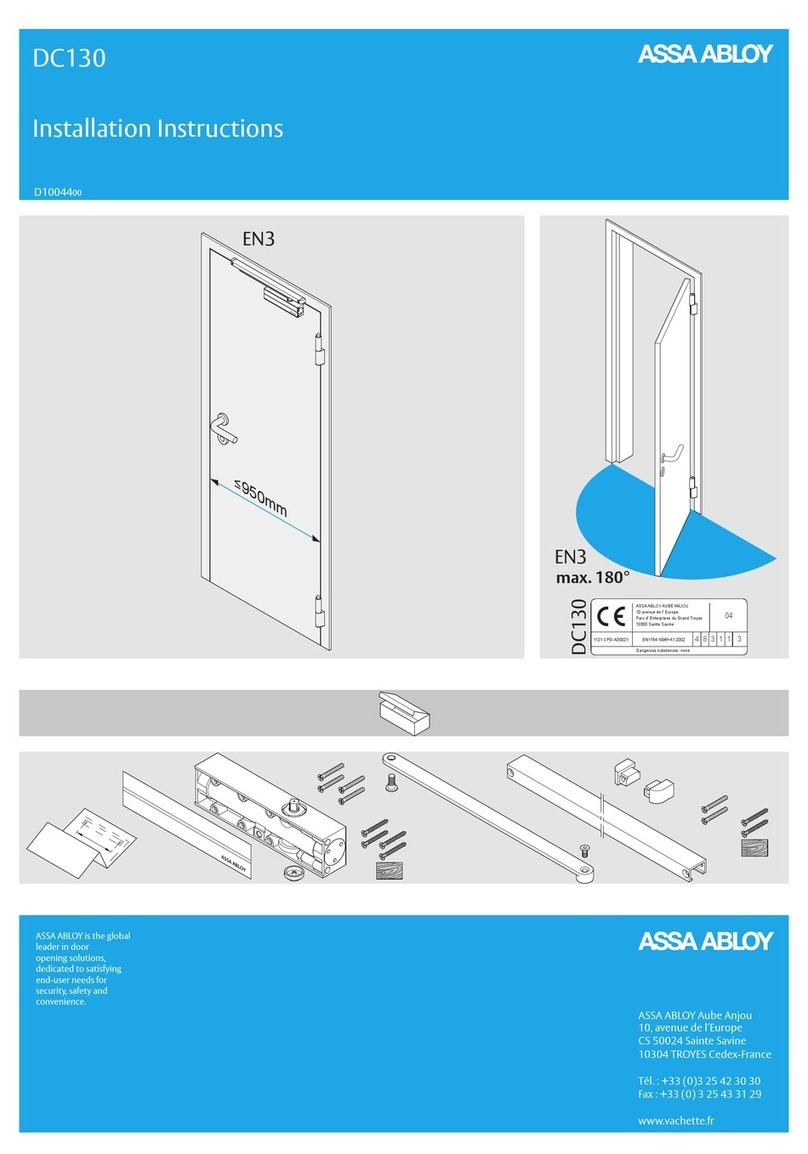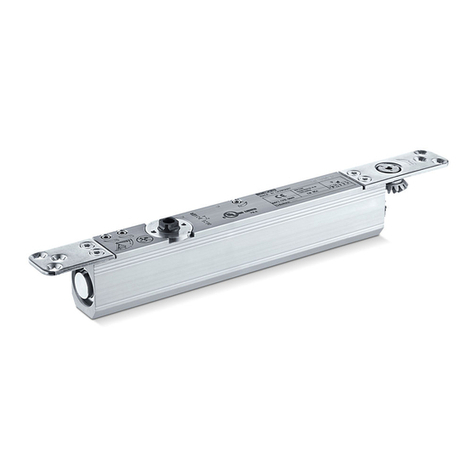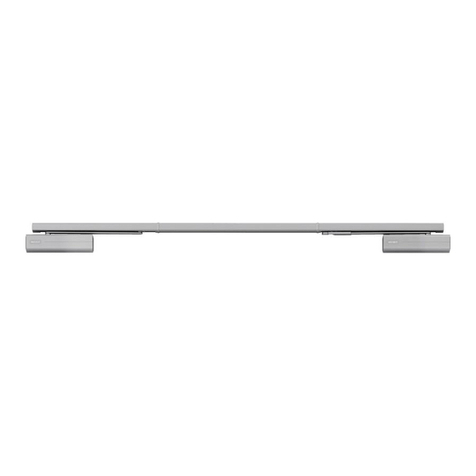GILGEN AS-844 R User manual

Arealschiebetorantrieb
Drive unit for site acces gates
Entraînement pour portails coulissants
extérieurs
Automazione per cancelli scorrevoli
AS-844 R (400 V)
Montage-undBetriebsanleitung
Assemblyandoperatinginstructions
Instructions de montage et d'exploitation
Istruzionidelmontaggioedelfunzionamento
4680-999/04
2004.09

.

4680-999-04_2004.09.p65 4680-999/04
AS-844 R
1-29
ED
Security
This manual for the drive unit for site acces gates AS-844 R:
- Supplies precise instructions for the assembly, the com-
missioning, the maintenance and troubleshooting.
- Is destined for the specialized personnel from the metal
construction and electrotechnical trades, who have been
accordingly authorized by the relevant authorities.
- Uses the following signs in order to point out certain dangers
and important remarks:
Warning
Involving danger to life and limb.
Attention
Asituationwherematerialcouldbedamagedorthe
function impaired.
Note
Hints which facilitate the work.
- Will be supplied together with the drive unit.
Theinstallation hasbeen checkedaccording tothe
regulations and answers the requirements of the
EMC directive regarding electromagnetic
compatibility(89/336/EEC)andlowvoltagedirective
(93/68/EEC).
The AS-844 R has been designed exclusively for operating
automaticsiteaccesgates.Themanufacturerresp.thedistributor
declines all responsibility for any applications outside of the
defined application objectives resp. limits.
Attention:
A faultless functioning of the Kaba Gilgen products
can only be guaranteed on condition that they are
used in conjunction with the original Kaba Gilgen
accessories(controlelements,safetyelements....),
otherwise Kaba Gilgen declines all responsibility
forasafeandreliablefunctioningoftheinstallation.
Priortothefirstcommissioningoftheinstallation,andatleastonce
ayear,thefunctionalsafetyoftheinstallationmustbecheckedby
a competent specialist.
Regular maintenance is absolutely necessary in order to gua-
rantee a long lifetime and a safe operation of the AS-844 R.
Maintenancemustbecarriedoutbyadequatelytrainedspecialists.
Should it be neglected or made by incompetent persons, the
manufacturerresp.thedistributordeclinesallresponsibilityforany
resulting damages or consequences. We recommend that you
conclude a maintenance contract with your distribution partner.
Each maintenance, troubleshooting and checking which has been
carried out must be entered into the control chart/master card.
Any subsequent interventions or modifications of the AS-844 R may
only be carried out by an authorized and specialized technician.
Should it not be possible to repair immediately any malfunctions
which might jeopardize the safety of the users, the operator of the
installation must be informed and the door be taken out of
operationifnecessary.Repairworkshallbecarriedoutassoonas
possible.
Sicherheit
Diese Anleitung zum Arealschiebetorantrieb AS-844 R:
- Gibt Ihnen klare Anweisungen für die Montage, Inbetriebset-
zung, Wartung und Störungsbehebung.
- Richtet sich an Fachpersonen aus dem Metall- und Elektroge-
werbe, welche von den zuständigen Behörden dazu autorisiert
wurden.
- Verwendet folgende Zeichen, um auf Gefahren und wichtige
Aussagen hinzuweisen:
Warnung
Wenn Leib und Leben in Gefahr sind.
Achtung
Wenn Material beschädigt werden kann oder die
Funktion beeinträchtigt wird.
Hinweis
Für Tipps, welche die Arbeit erleichtern.
- Wird zusammen mit dem Antrieb ausgeliefert.
Die Anlage wurde vorschriftsgemäss geprüft und
entspricht der Richtlinie für elektromagnetische
Verträglichkeit EMV (89/336/EWG) sowie der
Niederspannungs-Richtlinie (93/68/EWG).
Der AS-844 R wurde ausschliesslich für den Betrieb von auto-
matischen Arealschiebetoren konstruiert. Für Anwendungen, die
ausserhalbderdefiniertenAnwendungszweckeresp.Anwendungs-
grenzen liegen, übernimmt der Hersteller bzw. der Vertreiber
keine Haftung.
Achtung:
Die einwandfreie Funktion der Gilgen Produkte
kann nur zusammen mit der Verwendung von
originalGilgenZubehörteilen(Bedienungselemente,
Sicherheitselemente....) garantiert werden.
Andernfallslehnt GilgenjedeHaftung fürdiesiche-
re und störungsfreie Funktion der Anlage ab.
Die Anlage muss vor der ersten Inbetriebnahme und mindestens
einmal jährlich, von einem Sachkundigen auf ihren sicheren
Zustand geprüft werden.
Voraussetzung für einen dauerhaften und sicheren Betrieb des
AS-844 R ist eine regelmässige Wartung. Diese muss durch
geschulte Fachleute erfolgen. Wird sie vernachlässigt oder durch
nicht autorisierte Personen durchgeführt, kann der Hersteller
beziehungsweise der Vertreiber nicht für Schäden und deren
Folgen haftbar gemacht werden. Wir empfehlen Ihnen, mit Ihrem
Vertriebspartner einen Wartungsvertrag abzuschliessen.
Jede durchgeführte Wartung, Störungsbehebung und Kontrolle muss
im Prüfbuch/Stammkarte vollständig eingetragen werden.
Nachträgliche Eingriffe und Änderungen am AS-844 R dürfen
nur durch autorisiertes Fachpersonal vorgenommen werden.
Können Störungen, die zu gefährlichen Zuständen führen, nicht
sofort behoben werden, ist der Betreiber der Anlage zu informie-
renunddie Anlagenotfalls ausserBetrieb zusetzen.Die Instand-
stellung muss raschmöglichst erfolgen.
Modification reserved / Measures in mmÄnderungen vorbehalten / Masse in mm

4680-999-04_2004.09.p65 4680-999/04
AS-844 R
2-29
F I
Sécurité
Cemanuel pourl'entraînementpourportailscoulissants extérieur
AS-844 R:
- Vous donne des instructions précises pour le montage, la mise
en service, l'entretien et le dépannage.
- S'adresse au personnel spécialisé des métiers de la construc-
tion métallique et électro-technique ayant été autorisé par les
autorités respectives.
- Utilise les signes suivants afin d'attirer l'attention sur des dan-
gers et des remarques importantes:
Avertissement
Danger de blessure ou de mort.
Attention
Situationsusceptible d'endommagerle matérielou
d'entraver le fonctionnement.
Remarque
Des conseils qui vous facilitent le travail.
- Sera livré ensemble avec le mécanisme d'entraînement.
L'installation a été contrôlée selon les prescrip-
tions et répond aux exigences de la directive CEM
sur la compatibilité électromagnétique (89/336/
CEE)etde ladirectivebasse tension(93/68/CEE).
Le AS-844 R a été conçu exclusivement pour motoriser des
portailscoulissants extérieursautomatiques. Encas d'application
en dehors des objectifs resp. limites d'utilisation définies, le
fabricant resp. le distributeur décline toute responsabilité.
Attention:
UnfonctionnementirréprochabledesproduitsKaba
Gilgen ne peut être garanti que lorsqu'ils sont
utilisés ensemble avec les accessoires originaux
deKabaGilgen(élémentsdecommande,éléments
de sécurité....), sinon Kaba Gilgen décline toute
responsabilitépourun fonctionnementsûr et fiable
de l'installation.
Avant la première mise en service, et au moins une fois par an, la
sécuritédefonctionnementdel'installationdoitêtrecontrôléepar
un spécialiste compétent.
Afin d'assurer un fonctionnement sûr et durable du AS-844 R, un
entretien régulier est indispensable. Ce dernier doit être effectué
par du personnel dûment qualifié. Au cas où cet entretien serait
négligé ou exécuté par des personnes non compétentes, le
fabricant resp. le distributeur décline toute responsabilité en cas
de dégâts et leurs conséquences. Nous vous recommandons de
conclureuncontratd'entretienavecvotrepartenairededistribution.
Chaqueinterventiond'entretien,dedépannageet decontrôledoit
être inscrite dans le carnet de contrôle/la carte maîtresse.
Toute intervention ou modification ultérieure du AS-844 R est
exclusivement réservée au personnel dûment qualifié.
Au cas où il ne serait pas possible d'éliminer immédiatement des
malfonctionssusceptiblesdecompromettrelasécurité,l'exploitant
doitêtre notifiéetl'installationestà mettrehorsservice.Laremise
en état doit être effectuée au plus vite.
Sicurezza
Questo manuale per l'automazione per cancelli scorrevoli
AS-844 R:
- Vi fornisce instruzioni per il montaggio, la messa in funzione,
la manutenzione e l'eliminazione di guasti.
- S'indirizzaa delpersonalespecializatoinmestieri dell'industria
metallica o elettrica, autorizzati dalle autorità competenti a
questo compito.
- Usa i sequenti segnali per visualizzare meglio i pericoli ed i
riferimenti:
Avvertimento
Pericolo di ferite o di morte.
Attenzione
Puòesseredistruttodelmaterialeopuòinfluenzare
il funzionamento dell'installazione.
Nota
Per i consigli, che facilitano il lavoro.
- Viene consegnato con l'automazione.
L'installazione è stata controllata secondo le
prescrizioni e corrisponde alle norme CEM (89/
336/CEE) concernenti la Compatibilità Elettro
Magneticaedancheallenormeperlabassatensione
(93/68/CEE).
L'automazione AS-844 R è stata costruita esclusivamente per il
funzionamento automatico di cancelli scorrevoli. Il costruttore o il
venditore non si assume alcuna responsabilità per applicazioni
che sono al di fuori degli obiettivi o dei limiti definiti di applicazione.
Attenzione:
La funzione senza difetti dei prodotti Kaba Gilgen
può essere garantita solamente con l'impiego
d'accessori originali Kaba Gilgen (elementi di
comando,disecurezza....).AltrimentilaKabaGilgen
declina ogni responsabilità per una funzionalità
sicura e fidabile delle installazioni.
L'installazione,primadellaprimamessainfunzioneeperlomeno
una volta all'anno, deve essere controllata da un esperto per
quanto riguarda le condizioni di sicurezza.
Unaregolaremanutenzioneèilpresuppostodiunfunzionamento
duraturo e sicuro. Essa deve essere effettuata da personale
addestrato. Se viene trascurata od eseguita da persone non
autorizzate, il costruttore o il venditore non possono essere
considerati responsabili per danni e relative conseguenze. Vi
raccomandiamo di concludere un contratto di manutenzione con
il vostro partner di contratto.
Ogniinterventodimanutenzione,riparazionediguastoecontrollo
effettuatidevonoessereriportatisulregistrodicontrollo/scheda
dell'impianto.
Successivi interventi e modifiche sull'automazione AS-844 R
devonoessere eseguitesoltantoda personaleespertoautorizzato.
Se i guasti, che portano a situazioni di pericolo, non possono
essereeliminatiimmediatamente,l'utentedell'impiantodeveessere
informatoe incaso dinecessitàl'impiantodeveessere postofuori
servizio. I lavori di riparazione devono aver luogo il più presto
possibile.
Sottoposto a cambiamenti / Misure in mmSous réserve de changements / Mesures en mm

4680-999-04_2004.09.p65 4680-999/04
AS-844 R
3-29
~500
~400
~1'000
min. 250
207
40 / 58
115
107
min.
180
115
40 / 58
siehe Anhang:
see appendix: B1-0731-105
voir annexe: B1-0731-110
vedi appendice:
0...50
90°
90°
0...50
siehe Anhang:
see appendix: B1-0731-105
voir annexe: B1-0731-110
vedi appendice:
55
55
Fig.6
Fig.2Fig.1
Fig.3
Fig.4
Fig.5

4680-999-04_2004.09.p65 4680-999/04
AS-844 R
4-29
Fig.7
Fig.9
Fig.8
Fig.10

4680-999-04_2004.09.p65 4680-999/04
AS-844 R
5-29
AB
Fig.11
+ -
Fig.13 Fig.14
Fig.15 Fig.16
Fig.17
Fig.12

4680-999-04_2004.09.p65 4680-999/04
AS-844 R
6-29
D
Arealschiebetorantrieb AS-844 R
Der elektromechanische Arealschiebetorantrieb AS-844 R über-
trägt die Bewegung an das Tor über ein Ritzel, das hierzu in
geeigneter Weise mit einer am Tor befestigten Zahnstange im
Eingriff ist.
Durch dieses System wird das Tor bei stehendem Motor mecha-
nisch verriegelt, so dass sich die Installation eines Schlosses
erübrigt.
Die elektronische Steuerung UDC (mit Schützen, für zweistufige
Antriebe) wird gemäss UDC-Betriebsanleitung 0460-763 extern
montiert.
1 Beschreibung und technische
Eigenschaften
1 Befestigungswinkel
2 Ritzel z16
3 Induktiver Endschalter
4 Anschlussprint
5 Gehäusedeckel
6 Einstellschraube der Kupplung
7 Öleinfüllstutzen
8 Erdungsanschluss
9 Entriegelungssystem
Tab. 1
Technische Eigenschaften "Antrieb AS-844 R"
Versorgungsspannung 3 x 400 V; 50/60 Hz
Aufgenommene Leistung 950 W
Aufnahme 1,5 A
Elektromotor 4-polig, 1'400 min-1
Untersetzung 1 : 30
Kupplung Zweischeiben-Kupplung im Ölbad
Ritzel z16
Zahnstange Modul 4, Teilung 12,566
Max. Schubkraft 1'100 N (z16)
Wärmeschutz 130 °C (auf Motorwicklung)
Benutzungsfrequenz siehe Kapitel 1.1
Ölfüllung 2 l
Ölsorte Hydrauliköl XD 220
Aussentemperatur -20...+55 °C
Antriebsgewicht 14 kg
Schutzart IP55
Max. Torgewicht 1'800 kg
Torgeschwindigkeit 0,16 m/s (z16)
Max. Torlänge 15m(TIMEOUT)
Fig.18
1
2
3
45
7
8
6
9

4680-999-04_2004.09.p65 4680-999/04
AS-844 R
7-29
D
1.1 Maximale Benutzungskurve
Anhand dieser Kurve lässt sich die maximale Betriebszeit (T) je
nach Benutzungsfrequenz (F) berechnen.
Beispiel:
Der Antrieb AS-844 R kann bei einer Benutzungsfrequenz von
50 % im Dauerbetrieb eingesetzt werden.
Zur Gewährleistung eines störungsfreien Betriebes ist es erfor-
derlich, im Arbeitsbereich unter der Kurve zu bleiben.
Hinweis:
Die Kurve wurde bei einer Temperatur von 24 °C
erzielt. Die direkte Sonneneinstrahlung kann zu
einerVerringerungderBenutzungsfrequenzbis zu
20 % führen.
Berechnung der Benutzungsfrequenz
Es handelt sich um den Prozentsatz der Ist-Arbeitszeit (Öffnen +
Schliessen) zur gesamten Zykluszeit (Öffnen + Schliessen +
Pausenzeiten). Ta + Tc
Es gilt die Formel: % F = x 100
Ta + Tc + Tp + Ti
Ta = Öffnungszeit
Tc = Schliesszeit
Tp = Pausenzeit
Ti = Intervall zwischen zwei kompletten Zyklen
2 Vorbemerkungen
· DerInstallateursolldemAnwendersämtlicheInformationenzur
Notentriegelung des Systemes erteilen und ihm die dem Pro-
dukt beigelegte Anleitung aushändigen.
Warnung:
VorjeglichenArbeitenanderelektronischenSteue-
rung muss die Stromzufuhr unterbrochen werden!
DerelektrischenAnlage istein Fehlerstromschutz-
schalter mit 0,03 A Auslöseschwelle vorzuschal-
ten.
Bei Störungen bzw. fehlerhaftem Betrieb der Anla-
gedarfderAnwenderkeineeigenmächtigenRepa-
raturen oder Eingriffe vornehmen, sondern muss
ausschliesslich Fachpersonal damit beauftragen.
· Vor der Montage des Antriebes sind die Anleitungen auf-
merksam zu lesen und für künftigen Bedarf aufzubewahren.
· InstallationsowieelektrischeAnschlüssemüssendeneinschlä-
gigen Normen entsprechen.
· Das Versorgungsnetz des Antriebes ist durch einen allpoligen
Schalter mit Kontaktöffnungsabstand von mindestens 3 mm zu
schützen.Als AlternativekanneinMotorschutzschalter6 A(mit
allpoliger Unterbrechung) verwendet werden.
· Der Hersteller übernimmt keinerlei Haftung bei unsachge-
mässem und zweckentfremdetem Gebrauch des Antriebes.
3 Installation des Antriebes
3.1 Vorprüfungen
Um eine einwandfreie Funktion des Antriebes sicherzustellen,
muss die Struktur des bestehenden bzw. anzufertigenden Tores
folgenden Anforderungen entsprechen:
· Torgewicht nicht über 1'800 kg.
· Robuste und steife Torkonstruktion.
· Glatte (bündige) Toroberfläche ohne vertikale Elemente.
· Leichtgängige, lineare und gleichmässige Bewegung des To-
res im gesamten Laufbereich.
· Keine seitlichen Schwingungen des Tores.
· Perfekter Zustand der oberen und unteren Führungssysteme.
Der Einsatz einer Bodenführung mit abgerundeter Rille ist
wegen der geringen Laufreibung vorzuziehen. Ideal sind auch
freitragende Tortypen.
· Torbewegung durch nur 2 Laufräder.
· Mechanische Sicherheitsanschläge gegen Auslaufgefahr des
Tores; die Anschläge sind wahlweise am Boden oder an der
bodenseitigen Führung zu befestigen, ca. 20 mm hinter der
Endstellung.
·Keine mechanischen Verriegelungen.
Etwaige Schlosserarbeiten sollten vor der Installation des Tores
erfolgen.
Die Torkonstruktion hat direkten Einfluss auf die Zuverlässigkeit
und Sicherheit des Antriebes.
% Benutzungsfrequenz
0
10
20
30
40
50
60
70
80
90
100
123456789101112
Zeit (Std.)

4680-999-04_2004.09.p65 4680-999/04
AS-844 R
8-29
D
3.2 Installation des Antriebes
- Fundament für den Antrieb gemäss Fig. 1 vorbereiten.
Achtung:
Die Installationsrohre für die Anschlusskabel müs-
sen an der richtigen Stelle aus dem Boden austre-
ten (ca. 35 mm über den Boden vorstehen).
Tor nach links öffnend, siehe Fig. 2.
Tor nach rechts öffnend, siehe Fig. 3.
ZurAbschirmungvonelektrischenStörungenemp-
fiehltessich,Strom-undAnschlusskabelfürSignal-
geber und Sicherheiten (Tastenschalter, Empfän-
ger, Lichtschranken) in getrennten Rohren zu ver-
legen.
- Fundament erstellen.
- Stromkabel und Anschlusskabel für das Zubehör vorbereiten.
Füreinenmühelosen AnschlusssinddieKabelca.400mmvon
der Bohrung aus dem Fundament herauszuführen.
- Fundamentplatte vom Antrieb lösen und diese mittels drei
Schrauben und Dübeln auf das Fundament befestigen.
- Den Deckel des Antriebes abschrauben
- Antrieb gemäss Zeichnung B1-0731-105 auf die Fundament-
platte setzen. Hierbei die Kabel durch die in der unteren
Gehäusehälfte vorgesehene Führung in den Antrieb einzie-
hen. Die Kabel mit Hilfe der mitgelieferten Kabelpresse aus
GummidurchdieentsprechendenÖffnungenzureletronischen
Steuerung führen.
Dafür sind die Kabelmäntel zu entfernen, so dass die Kabel-
presse lediglich auf den einzelnen Drähten haftet (Fig. 11).
- Antrieb auf Ritzelhöhe 112 mm einstellen und provisorisch
festschrauben.
- Die externe Steuerung UDC gemäss UDC-Betriebsanleitung
0460-763 anschliessen.
Warnung:
DasErdungskabelderAnlagegemässFig.18/Pos.
8 anschliessen.
3.3 Montage der Zahnstange
Bei Auftragserteilung wird entschieden, wie die Zahnstange an
dasTormontiertwird.EsstehenfolgendedreiMontage-Varianten
zur Verfügung:
3.3.1
Stahl-Zahnstange direkt aufs Tor geschweisst mittels
Anschweissbolzen (Fig. 7/8, Zeichnung B1-0731-105 Var.
geschweisst).
3.3.2
Stahl-Zahnstange direkt aufs Tor geschraubt
mittels Bohren von Gewindelöchern (Zeichnung B1-0731-105
Var. geschraubt).
3.3.3 (Vorzugs-Variante)
Stahl-Zahnstange auf Gilgen-Aluminiumprofil
mittels Bohren von Gewindelöchern (Zeichnung B1-0731-110
und Beispiele B2-0731-113/114/116).
3.3.1 Stahl-Zahnstange direkt aufs Tor geschweisst
- Anschweissbolzen mit Zahnstangenschrauben an die Zahn-
stangenelemente vormontieren (Fig. 7).
Hinweis:
DieZahnstangenschraubenobenimLanglochfest-
ziehen,um dieZahnstange beimallmählichenSet-
zen des Tores nachträglich anheben zu können.
- Den Antrieb entriegeln (siehe Kapitel 5).
- Den Torflügel von Hand in die Offenstellung bewegen.
- Das erste Zahnstangenelement beim ersten Distanzstück auf
das Ritzel legen (Fig. 8).
- Das Zahnstangenelement mittels einer Schraubzwinge am Tor
befestigen (Fig. 8).
- Das Tor bis zum dritten Distanzstück der Zahnstange manuell
in Schliessrichtung bewegen und Distanzstück mittels einem
Schweisspunkt anheften.
- Die drei Distanzstücke endgültig am Tor anschweissen.
Zur Befestigung der anderen Zahnstangenelemente, bis hin zur
Schliessposition des Tores, ist folgendermassen vorzugehen:
- Ein weiteres Zahnstangenelement an das zuletzt befestigte
Element ansetzen, wobei ein Zahnstangenteil von ca. 150 mm
für die richtige Verzahnungsfolge der beiden Elemente zu
verwenden ist (Fig. 10).
- Das Tor von Hand in Schliessrichtung bewegen, bis das Ritzel
dasdritteDistanzstückdesZahnstangenelementesüberfahren
hat (Fig. 10).
Achtung:
Sämtliche Zahnstangenelemente müssen genau
mittig in die Ritzelzähne eingreifen. Andernfalls
den Antrieb entsprechend verschieben.
- Die drei Distanzstücke des Elementes anschweissen (Fig. 10).
Achtung:
Die Zahnstangenelemente dürfen auf keinen Fall
mit den Distanzstücken bzw. miteinander ver-
schweisst werden.
- Antrieb mittels vier M10-Gewindestiften (Pos. 6 der Zeichnung
B1-0731-105) um 1,5 mm (~ 1 Umdrehung) absenken, um
damit das Verzahnungsspiel zwischen Ritzel und Zahnstange
herzustellen (Fig. 9). Antrieb mittels vier 6kt-Muttern wieder
festschrauben.
- Die komplette und ungehinderte Öffnung des Tores von Hand
überprüfen,wobeidieBewegungleichtgängig undlinearablau-
fen soll.
Achtung:
Das Verzahnungsspiel zwischen Ritzel und Zahn-
stange muss 1,5 mm betragen (Fig. 9). Bei neuen
Torkonstruktionen das Spiel einige Monate nach
Installation überprüfen.
Ritzel und Zahnstange auf keinen Fall einfetten
oder mit anderen Produkten schmieren.

4680-999-04_2004.09.p65 4680-999/04
AS-844 R
9-29
D
3.3.2 Stahl-Zahnstange direkt aufs Tor geschraubt
Montagevorgang analog Kapitel 3.3.1. An Stelle des Schweis-
sens: Gewindelöcher anzeichnen, bohren und Gewinde schnei-
den.
Achtung:
Vor dem Bohren überprüfen, ob keine anderen
Teile dabei beschädigt oder behindert werden.
Falls z. B. Lauf- oder Führungsrollen vorbeilaufen
unddiesetouchierenwürden,kanndieseMontage-
Variante nicht durchgeführt werden ÖÖ
ÖÖ
Öausweichen
auf eine der beiden anderen Varianten.
3.3.3 Stahl-Zahnstange auf Gilgen-Aluminiumprofil
gemäss Zeichnung B1-0731-110
- Vorhandene Aluminiumprofile (Pos. 1) wie abgebildet an Tor-
flügel montieren (mindestens jedes fünfte Langloch).
- Zahnstangenelement (6) provisorisch an Aluminiumprofil (1)
montieren, ganz anheben und mittels den beiden äussersten
Schrauben (7) leicht fixieren.
- Den Antrieb entriegeln (siehe Kapitel 5).
- Den Torflügel von Hand in die Offenstellung bewegen.
- Am ersten Zahnstangenelement die Schrauben (7) lösen und
am äussersten Ende auf das Ritzel legen. Schraube (7) auf
Ritzelhöhe anziehen.
- Das Tor manuell bis zum anderen Ende des ersten Zahn-
stangenelementesinSchliessrichtungbewegenunddiedortige
Schraube (7) festziehen. Anschliessend die mittlere Schraube
festziehen.
Zur Befestigung der anderen Zahnstangenelemente, bis hin zur
Schliessposition des Tores, ist folgendermassen vorzugehen:
- Ein weiteres Zahnstangenelement an das zuletzt befestigte
Element ansetzen, wobei ein Zahnstangenelement von ca.
150 mmfürdierichtigeVerzahnungsfolgederbeidenElemente
zu verwenden ist (Fig. 10).
- Das Tor von Hand in Schliessrichtung bewegen, bis das Ritzel
kurz vor dem Ende des Zahnstangenelementes steht.
Achtung:
Sämtliche Zahnstangenelemente müssen genau
mittig in die Ritzelzähne eingreifen. Andernfalls
den Antrieb entsprechend verschieben.
- Die Schrauben (7) des Elementes anziehen.
Wenn alle Zahnstangenelemente montiert sind:
- Antrieb mittels vier M10-Gewindestiften (Pos. 6 der Zeichnung
B1-0731-110) um 1,5 mm (~ 1 Umdrehung) absenken, um
damit das Verzahnungsspiel zwischen Ritzel und Zahnstange
herzustellen (Fig. 9). Antrieb mittels vier 6kt-Muttern wieder
festschrauben.
- Die komplette und ungehinderte Öffnung des Tores von Hand
überprüfen,wobeidieBewegungleichtgängig undlinearablau-
fen soll.
Achtung:
Das Verzahnungsspiel zwischen Ritzel und Zahn-
stange muss 1,5 mm betragen (Fig. 9). Bei neuen
Torkonstruktionen das Spiel einige Monate nach
Installation überprüfen. Ritzel und Zahnstange auf
keinen Fall einfetten oder mit anderen Produkten
schmieren.
3.4 Montage der Endschalterbleche
DurchdeninduktivenNäherungs-Endschalter(Fig.18/Pos.3)des
Antriebes AS-844 R wird der Durchlauf eines entsprechenden
BlechesaufderZahnstangeerkanntundsomitdieBewegungdes
Tores gestoppt.
Achtung:
Der Abstand zwischen Endschalter und Blechen
muss ≤5 mm betragen (Zeichnung B1-0731-105
oder B1-0731-110).
Bei Montage-Variante 3.3.3 werden spezielle Endschalterbleche
mitgeliefert, welche in der oberen Nute des Gilgen-Aluminium-
profiles gemäss Zeichnung B1-0731-110 befestigt werden.
Zur ordnungsgemässen Montage der zwei mitgelieferten
Endschalterbleche ist wie folgt vorzugehen:
- Die Stromversorgung einschalten.
- Das Blech in Öffnungsrichtung auf Zahnstange/Aluminium-
profil verschieben, bis der Antrieb in Offenposition anhält.
Anschliessend Blech auf der Zahnstange anheften oder am
Aluminiumprofil leicht festschrauben.
- DasBlech in SchliessrichtungaufZahnstange/Aluminiumprofil
verschieben, bis der Antrieb in Geschlossenposition anhält.
Anschliessend das Blech auf der Zahnstange anheften oder
am Aluminiumprofil leicht festschrauben.
- Das System verriegeln (siehe Kapitel 5).
Achtung:
Vor Impulsausgabe sicherstellen, dass keine ma-
nuelle Torbewegung möglich ist.
- Einen abgeschlossenen Torzyklus einleiten und hierbei die
Funktion des Endschalters überprüfen.
Achtung:
Um Antriebsschäden bzw. Betriebsunterbrechun-
gen zu vermeiden, rund 20 mm Abstand von den
mechanischen Endanschlägen belassen.
- Die Endschalter-Bleche endgültig auf Zahnstange anschweis-
sen oder am Gilgen-Aluminiumprofil festschrauben.
Hinweis:
Je nach Montagerichtung ("schliessen nach links"
oder "schliessen nach rechts") müssen die
Motoranschlusskabel am Anschlussprint ver-
tauscht werden.

4680-999-04_2004.09.p65 4680-999/04
AS-844 R
10-29
D
5 Manueller Betrieb
Sollte infolge von Stromausfällen bzw. Betriebsstörungen ein
manueller Torbetrieb erforderlich sein, ist das Entriegelungs-
system wie folgt zu betätigen:
Achtung:
Vor Impulsausgabe sicherstellen, dass keine ma-
nuelle Torbewegung möglich ist.
- SchutzklappeöffnenundmitgeliefertenSchlüsselindasSchloss
einstecken (Fig. 12).
- Schlüssel im Uhrzeigersinn drehen und den Hebel des
Entriegelungssystems gemäss Fig. 14 ziehen.
- Zur anschliessenden Systemverriegelung den Hebel in die
Ausgangsposition bringen (Fig. 17).
6 Elektronische Steuerung
Hinweis:
Die Steuerung wird gemäss UDC-Betriebsanlei-
tung 0460-763 extern montiert.
4 Inbetriebnahme
4.1 Einklemmschutz-Systemeinstellen
DurchdiemechanischeEinklemmschutz-KupplungdesAntriebes
AS-844 R wird die Torbewegung bei einem Hindernis gestoppt.
Die Beseitigung des Hindernisses bewirkt die Wiederaufnahme
der Torbewegung bis zur Belegung des Endanschlages bzw.
zum Ablauf der eingegebenen Betriebszeit (TIME-OUT).
Warnung:
DieSicherheitskupplungmussunbedingtnachden
geltenden Normen eingestellt werden. Auf jeden
Fall rät der Hersteller von einem am Tor gemesse-
nen Wert über 150 N ab.
Zum Zweck der präzisen Einstellung muss eine Federwaage
verwendet werden. Der Ansprechwert des Einklemm-Schutz-
systemes wird folgendermassen eingestellt:
- Die Stromversorgung des Systemes unterbrechen.
- Antriebswelle mittels Schraubenschlüssel kontern und den
Einstellstift der Kupplung gemäss Fig. 13 einstellen:
· Einstellstift zur Erhöhung des Drehmomentes im Uhrzei-
gersinn drehen.
· Einstellstift zur Verringerung des Drehmomentes gegen
den Uhrzeigersinn drehen.
Achtung:
Bei Lieferung des Antriebes ist die Kupplung auf
das Höchstmoment eingestellt. Das Drehmoment
des Systemes muss daher als erstes verringert
werden.
- DasSystemmit Stromversorgenund denrichtigenEingriff des
Einklemmschutz-Systemes kontrollieren.
Achtung:
Der Antrieb wird mit Kupplungs-Einstellfeder für
Tore bis 1'000 kg Gewicht geliefert. Bei schwere-
ren Toren daher unbedingt die mitgelieferte
Feder verwenden.
ZumFederaustausch dieAngaben gemässFig.15
befolgen.
4.2 Betrieb
- DieelektronischeSteuerung UDCgemäss seperaterBetriebs-
anleitung 0460-763 in Betrieb nehmen.
- EinigeabgeschlosseneTorzyklensteuern,umdieeinwandfreie
Funktion von Antrieb und Zubehör sicherzustellen.
Achtung:
Zum Schutz des Systemes darf derAnschlussprint
während der Antriebsfunktion nicht abgenommen
werden.
- Den Deckel des Antriebes wieder aufsetzen uns festschrau-
ben.

4680-999-04_2004.09.p65 4680-999/04
AS-844 R
11-29
D
7 Besondere Anwendungen
Besondere Anwendungen sind nicht vorgesehen.
8 Wartung
Die Wartung soll durch geschulte Fachleute gemäss Service-
Checkliste 4.06.09.051.1 im Anhang erfolgen.
DieEinstellung dermechanischenKupplung sowieder elektroni-
schen Einklemmsicherheit ist ebenfalls einer regelmässigen
Kontrolle zu unterziehen.
Die Funktion des Entriegelungssystems überprüfen.
Die Sicherheitsvorrichtungen auf der Anlage sind mind. 1 mal
jährlich zu überprüfen.
Den Ölstand regelmässig überprüfen. Bei einer mittleren bis
niedrigen Benutzungsfrequenz ist eine Kontrolle alle 2 Jahre
ausreichend. Bei häufiger Benutzung muss die Prüfung einmal
jährlich ausgeführt werden.
DurchAbnehmenderEinfüllschraubewirdderÖlbehälterzugäng-
lich.BeiderSichtkontrollemuss dasÖl dieKupferwicklungen des
Elektromotors berühren (Fig. 16).
Bei Nachfüllbedarf ausschliesslich Hydrauliköl XD 220 verwen-
den.
9 Störungsbehebung
FürInstandsetzungsarbeitensinddieautorisiertenGilgen-Service-
stellen zuständig.
10 Entsorgung
Antriebund Zubehördemontieren undnach Werkstoffengetrennt
der Wiederverwertung zuführen.
Warnung:
Öl ablassen und dieses der Ölsammelstelle zufüh-
ren.
Anhang
Service-Checkliste .................................................4.06.09.051.1
Zeichnung ............................................................... B1-0731-105
Zeichnung ............................................................... B1-0731-110
Zeichnung ............................................................... B2-0731-113
Zeichnung ............................................................... B2-0731-114
Zeichnung ............................................................... B2-0731-116

4680-999-04_2004.09.p65 4680-999/04
AS-844 R
12-29
E
Drive unit AS-844 R for site
access sliding gate
The electromechanical drive unit AS-844 R for site access sliding
gatestransmitsthemovementtothegateleafbymeansofapinion
coupledinanappropriatemannertoarackthatisfixedtothegate.
This system ensures that the gate is mechanically locked when
the motor is not running, which means that no lock is required.
The electronic control UDC (with contactors, for two-stage drive
units) is externally installed according to the UDC operating
instructions 0460-763.
1 Description and technical
characteristics
1 Fixing angle
2 Pinionz16
3 Inductive limit stop switch
4 ConnectionPCB
5 Housing cover
6 Adjusting screw for clutch
7 Oilfillingplug
8 Earth connection
9 Release system
Table 1
Technical characteristics "Drive unit AS-844 R"
Power supply 3 x 400 V; 50/60 Hz
Absorbed power 950 W
Current drawn 1,5 A
Electric motor 4-pole, 1'400 min-1
Gear reduction ratio 1 : 30
Clutch Twin-disk coupling in oil bath
Pinion z16
Toothed rack Modul 4, Teilung 12,566
Max. thrust force 1'100 N (z16)
Thermal protection 130 °C (on motor coil)
Frequency of use see chapter 1.1
Oilfilling 2 l
Oil type Hydraulic oil XD 220
External temperature -20...+55 °C
Drive unit weight 14 kg
Protection rating IP55
Max. gate weight 1'800 kg
Gate speed 0,16 m/s (z16)
Max. gate length 15m(TIMEOUT)
Fig.18
1
2
3
45
7
8
6
9

4680-999-04_2004.09.p65 4680-999/04
AS-844 R
13-29
E
1.1 Maximum duty cycle curve
Thecurvemakes itpossibleto determinethemaximum operating
time (T) with respect to the duty cycle (F).
Example:
The AS-844 R drive unit can work continuously at a duty cycle of
50 %.
To ensure smooth running, operation should be kept within the
duty area under the curve.
Note:
The curve was plotted on the basis of operation at
a temperature of 24 °C. Allow for up to 20 %
reduction of the duty cycle in case of exposure to
direct sunlight.
Calculating the duty cycle
The duty cycle is the percentage of the actual operating time
(opening plus closing) compared with the total time of the cycle
(opening plus closing plus pause time).
Ta + Tc
The formula for calculating: % F = x 100
Ta + Tc + Tp + Ti
Ta = opening time
Tc = closing time
Tp = pause time
Ti = interval between a complete cycle and the next
2 Important notes
· The installer must provide the user with all information related
tothereleasesystemincaseofemergencyandhandovertothe
end-userthisinstructionbookletwhichisattachedtotheproduct.
Warning:
Switch off power supply before performing any
work on the electronic control unit!
Check that up-line to the electrical system there is
a differential switch with a trip threshold of 0,03 A.
In case of breakdown and/or malfunction the user
must avoid any attempt to repair or adjust the
automation personally and only contact a qualified
specialist.
· Read these instructions carefully before installing the gate
automationsystem.Keeptheseinstructionsforfuturereference.
· Installation and electrical wiring must conform to current
standards.
· Install a multi-pole switch with a contact spacing equal or over
3 mm on the mains supply line. In alternative the use of a 6 A
thermo-magnetic breaker with multi-pole switching is
recommended.
· Themanufactureracceptsnoresponsibilityfordamageorinjury
resulting from the incorrect use of this drive unit.
3 Installation of the drive unit
3.1 Preliminary checks
Toensuretrouble-freeoperation,makesurethatthegate(whether
existing or yet to be installed) has the following specifications:
· Max. gate weight 1'800 kg.
· Strong and rigid leaf frame.
· Flatleafface, withnoprotrudingparts andnoverticalmembers.
· Smooth and even movement of the leaf over its entire travel.
· No sideways oscillation of the leaf.
· Upper and lower sliding system in perfect condition (the use of
floortrackingwitharoundedchannelistobepreferred,because
itreducesfrictionintheslidingmovement).Self-supportinggate
types are also an ideal application.
· Only two slide wheels.
· Mechanical safety stops to avoid risk of derailment; they must
be firmly fixed to the ground or to the floor track, about 20 mm
beyond the travel limit.
·No mechanical lock.
Ifanywelding orbrazingis requiredonthe gate,itshould bedone
before installing the drive unit.
The condition of the structure directly affects the reliability and
safety of the drive unit.
% Duty cycle
0
10
20
30
40
50
60
70
80
90
100
123456789101112
Time (h)

4680-999-04_2004.09.p65 4680-999/04
AS-844 R
14-29
E
3.2 Installing the drive unit
- Prepare the foundation for the drive unit according to Fig. 1.
Attention:
The installation tubing for the connecting cables
must emerge from the floor in the right place (and
jut out approx. 35 mm over floor level).
Door opening to the left: see Fig. 2
Door opening to the right: see Fig. 3
To avoid electrical noises and interferences, it is
recommendedtokeepseparatepipesforthepower
cables and the control and safety wiring (buttons,
receivers, photocells).
- Carry out the foundation.
- Prepare the cables for the connection with the accessories and
power supply. To make the electrical wiring on the electronic
systemeasier,leave about400 mmof freecable outofthe hole
in the foundation.
- Detach the foundation plate from the drive unit and fasten the
plate onto the foundation, using three screws and dowels.
- Open the cover of the operator.
- Place the drive unit on the base plate, as shown in drawing B1-
0731-105. During this operation, pass the electrical wiring
cables through the conduit in the lower part of the drive unit.
To access the electric control, pass the cables through the
relevant bores up to the electronic control, using the cable
clampsupplied.Todothis,removethecablesheathings,sothat
the cable clamp is only applied to the individual wires (Fig. 11).
- Adjust the drive unit on the height of the pinion 112 mm and
fasten it provisionally.
- Connect up the cables to the external UDC control according
to the UDC operating instructions 0460-763.
Warning:
Connect up the earth cable of the system to the
position shown in Fig. 18/item 8
3.3 Assembling therack
The decision as to how the toothed rack will be mounted onto the
gate will be taken after contract award. The following three
installation possibilities are available:
3.3.1
Toothed steel rack directly welded onto the gate, by means of
welding bolts (Fig. 11/12/13, drawing B1-0731-105, welded
version).
3.3.2
Toothedsteelrackdirectlyscrewedontothegate,upondrilling
holes (drawing B2-0731-105, screwed version).
3.3.3 (this version is to be preferred)
Toothed steel rack screwed on Gilgen aluminium profile, upon
drilling threaded holes (drawing B1-0731-110 and examples
B2-0731-113/114/116).
3.3.1 Toothed steel rack directly welded onto the gate
- Sub-assemblethe weldingboltwiththeelements ofthetoothed
rack, using the rack fixing screws (Fig. 7).
Note:
Tighten the rack fixing screws in the top of the slot.
This allows the rack to be raised if, with time, the
gate tends to sink.
- Release the drive unit (see chapter 5).
- Slide the gate leaf open by hand.
- Lean the first tooth of the rack on the pinion in line with the first
spacer (Fig. 8).
- Fix the rack tooth to the leaf with a clamp (Fig. 8).
- Close leaf unitl it is in line with the third spacer on the rack, and
spot weld the spacer in position (in one point).
- Completely weld the three spacers to the gate.
To fix the additional rack sections, which are necessary to reach
the closed position, proceed as follows:
- Line up another rack section to the last one fixed to the gate.
To check that the teeth are correctly spaced, use a section of
rack about 150 mm long as shown in Fig. 10.
- Slidethegatecloseduntilthepinionisinlinewiththethirdspacer
of the section being fixed (Fig. 10).
Attention:
Check that all the rack's sections work on the
centreofthepinion's teeth.Ifnotadjustthe position
of the drive unit.
- Weld the three spacers (Fig. 10).
Attention:
Do not, for any reason, weld the rack sections to
either the spacers or each other.
- By means of the four M10 set screws (pos. 6 on drawing
B1-0731-105), lower the drive unit by 1,5 mm (approx. 1 turn),
in order to allow for the gearing play between the pinion and
the toothed rack (Fig. 9). Then screw down the drive unit using
the four hexagon nuts.
- Check by hand that the gate is free to open completely and that
the leaf movement is smooth and with no stiff points.
Attention:
Theremustbe aplayof 1,5mm in theengagement
between the pinion and rack (Fig. 9). If the gate is
new then check the engagement after a few
months. Never use grease or other lubricants on
the pinion and rack.

4680-999-04_2004.09.p65 4680-999/04
AS-844 R
15-29
3.3.2 Toothed steel rack directly screwed onto the gate
Assembly procedure as described in chapter 3.3.1. Instead of the
welding procedure, mark and drill the holes and cut the thread.
Attention:
Prior to drilling make sure that no other elements
canbedamagedorhindered.Ifforexamplecarrying
wheels or guideway rollers are passing nearby
whichwouldtouchthescrews,thisassemblyversion
cannot be used ÖÖ
ÖÖ
Öselect instead one of the other
two assembly methods.
3.3.3 Toothed steel rack on Gilgen aluminium profile
according to drawing B1-0731-110
- Mounttheexisting aluminiumprofiles(pos.1) acc.toillustration
to the gate leaf (using at least every fifth slot).
- Provisionally fasten the toothed rack section (6) against the
aluminiumprofile (1),liftit upcompletelyand slightlyfastenit by
means of the two outer screws (7).
- Release the drive unit (see chapter 5).
- Slide the gate leaf open by hand
- Loosenthescrews(7)onthefirsttoothedracksectionandplace
it on the outer extremity of the pinion. Tighten the screw (7) on
the level of the pinion.
- Manually move the gate in closing direction up to the other
extremity of the first toothed rack section and tighten the screw
(7) which is located there. Then tighten the center screw.
To fix the additional rack sections, which are necessary to reach
the closed position, proceed as follows:
- Lineupanother racksection tothelast onefixed tothegate. To
check that the teeth are correctly spaced, use a section of rack
about 150 mm long as shown in Fig. 10.
- Manually move the gate in closing direction until the pinion is
located shortly before the end of the toothed rack section.
Attention:
Checkthatalltherack'ssectionsworkonthecentre
of the pinion's teeth. If not adjust the position of the
drive unit.
- Tighten the screws (7) of the rack section.
After all the toothed rack sections have been mounted:
- By means of the four set screws M10 (pos. 6 of drawing B1-
0731-110), lower the drive unit by 1,5 mm (approx. 1 turn) in
ordertoallowforthenecessarygearingplaybetweenthepinion
and the toothed rack (Fig. 9). Screw down the drive unit by
means of the four hexagon nuts.
- Check by hand that the gate is free to open completely and that
the leaf movement is smooth and with no stiff points.
Attention:
Theremustbe aplayof 1,5mm in theengagement
between the pinion and rack (Fig. 9). If the gate is
new then check the engagement after a few
months. Never use grease or other lubricants on
the pinion and rack.
E
3.4 Positioning the travel stop plates
The AS-844 R drive unit is equipped with an inductive limit switch
(Fig.18/item3)which,whenitdetectsthepassageofa platefitted
to the top of the rack, stops the gate movement.
Attention:
The distance between the sensor and plate must
be≤5mm(drawingB1-0731-105orB1-0731-110).
Forassemblyversion 3.3.3special travel stopplates areincluded
in the supply which have to be fastened in the upper groove of
the Gilgen aluminium profile, according to drawing B1-0731-110.
In order to mount the two supplied travel stop plates correctly,
proceed as follows:
- Switch on the power supply.
- Slide the plate along the rack /aluminium profile in the opening
direction until the drive unit stops in the open position. Then fix
it to the rack or slightly screw it into the aluminium profile.
- Slide the plate along the rack/aluminium profile in the closing
direction until the drive unit stops in the closed position. Then
fix it to the rack or slightly screw it into the aluminium profile.
- Lock the system (see chapter 5).
Attention:
Before giving a signal ensure that the gate will not
movemanually.
- Run a complete cycle of the gate to check that the travel limits
are working properly.
Attention:
Toavoiddamagingthedriveunitand/orblockingthe
automation system leave about 20 mm from the
mechanical travel stops.
- Complete the welding of the travel stop plates to the rack or
screw them into the Gilgen aluminium profile.
Note
Depending on the assembly direction "closing to
the left" or "closing to the right"), the motor con-
nection cables must be exchanged on the PCB.

4680-999-04_2004.09.p65 4680-999/04
AS-844 R
16-29
E
5 Manual operation
Should the need arise to operate the gate manually because of a
power failure or malfunction, release it by means of the new
releasing device. Proceed as follows:
Attention:
Before giving a signal ensure that the gate will not
move manually.
- Open the lid of the lock and insert the relative key in the lock
(Fig. 23).
- Turn the key clockwise and pull the releasing lever as shown in
Fig. 24.
- Tore-lock thesystem,return theleverof thereleasingdeviceto
its initial position.
6 Electronic control
Note:
The control is externally mounted according to the
UDC operating instructions 0460-763.
4 Start-up
4.1 Adjustmentofanti-crushingsystem
The AS-844 R automation system is equipped with an anti-
crushing mechanical clutch which stops the opening/closing if the
gate meets an obstacle during its movement. When the obstacle
isremoved,the gateresumes itsmovement untiltherelevant limit
switch trips or the safety time (TIME-OUT) is over.
Warning:
This torque limiter must be set in compliance with
current standards. In any case, the manufacturer
advisesyounottoexceed150Nofforce,measured
on the leaf.
Useaspringbalancetoensurethatthemeasurementisperformed
accurately. To adjust the threshold of the anti-crushing system,
proceed as follows:
- Switch off the power supply.
- Keep the driving shaft in position by means of a wrench, and
adjust the clutch adjusting dowel, as shown in Fig. 13.
· To increase torque, turn the dowel clockwise.
· To decrease torque, turn the dowel counterclockwise.
Attention:
The drive unit is supplied with the clutch set to
maximumtorque.Initially,theworkingtorqueofthe
system must be decreased.
- Switch on the power supply and check whether the anti-
crushing system trips correctly.
Attention:
The drive unit is factory-equipped with a clutch
adjustmentspringforgatesweighingupto1'000 kg.
For heavier gates, fit the spring supplied.
The procedure for replacing the spring is shown in
Fig. 15.
4.2 Start-up
- Taketheelectroniccontrol UDCinto operationaccordingtothe
separate operating instructions 0460-763.
- Perform a few complete cycles in order to verify whether the
automation system and all the accessories are in working
order.
Attention:
To avoid damaging the system, never remove the
connection PCB when the drive unit is running.
- Remount the cover of the drive unit and screw it down.

4680-999-04_2004.09.p65 4680-999/04
AS-844 R
17-29
E
7 Special applications
There are no special applications.
8 Maintenance
Maintenancemustbecarriedoutbyadequatelytrainedspecialists
according to the enclosed service check list 4.06.09.051.4.
Theoillevelshouldbecontrolledperiodicallyusingthereferences
onthedip-stick oftheoilfillerplug.With mediumtolowduty cycles
it is sufficient to check it every 2 years. Control it annually with
heavy duty cycles.
The tank can be accessed through the oil filler plug. The oil level
can be controlled visually, and must soak the electric motor's
copper coil (Fig. 16).
Any top ups must be made exclusively with hydraulic oil XD 220.
Itisalsonecessarytocheckperiodicallyboththecorrectadjustment
of the mechanical clutch and the efficiency of the electronic anti-
crushing safety system.
Also check the efficiency of the release system.
The safety devices must be checked every six months.
9 Troubleshooting
All troubleshooting interventions must be carried out by the
authorized Gilgen service centers.
10 Disposal
Disassemble the drive unit and the accessories into its individual
parts in order to recycle the different materials.
Warning:
Let off the oil and bring it to the wasge oil collecting
bin.
Appendix
Service check list ...................................................4.06.09.051.4
Drawing................................................................... B1-0731-105
Drawing................................................................... B1-0731-110
Drawing................................................................... B2-0731-113
Drawing................................................................... B2-0731-114
Drawing................................................................... B2-0731-116

4680-999-04_2004.09.p65 4680-999/04
AS-844 R
18-29
F
Entraînement pour portails
coulissants extérieurs AS-844 R
L'entraînement AS-844 R est un entraînement électromécanique
quitransmetlemouvementauvantailparunpignonentraînantune
crémaillère, solidaire du portail.
Le système garantit le verrouillage mécanique du portail lorsque
lemoteurestarrêté,nenécessitantpasl'installationd'uneserrure.
La commande électronique UDC (avec contacteurs pour des
entraînementsà2vitesses)estmontéeàunendroitexterneselon
les instructions d'exploitation UDC 0460-763.
1 Description et caractéristiques
techniques
1 Cornières de fixation
2 Pignon z16
3 Fin de course inductif de proximité
4 Circuit imprimé de raccordement
5 Couvercle du boîtier
6 Vis de réglage de l'embrayage
7 Bouchon de remplissage d'huile
8 Mise à la terre
9 Système de déblocage
Tab. 1
Caractéristiques techniques "Entraînement AS-844 R"
Alimentation 3 x 400 V; 50/60 Hz
Puissance absorbée 950 W
Courant absorbé 1,5 A
Moteur électrique 4 pôles, 1'400 min-1
Rapport de réduction 1 : 30
Embrayage double disque à bain d'huile
Pignon z16
Crémaillère module 4, pas 12,566
Force de poussée maxi 1'100 N (z16)
Interv. disjoncteur therm. 130 °C (sur bobinage)
Fréquence d'utilisation voir chapitre 1.1
Quantitéd'huile 2 l
Type d'huile huile hydraulique XD 220
Températureambiante -20...+55 °C
Poidsd'entraînement 14 kg
Degré de protection IP55
Poids maxi du portail 1'800 kg
Vitesse linéaire 0,16 m/s (z16)
Longueur maxi du portail 15m(TIMEOUT)
Fig.18
1
2
3
45
7
8
6
9
Table of contents
Languages:
Other GILGEN Door Opening System manuals
Popular Door Opening System manuals by other brands
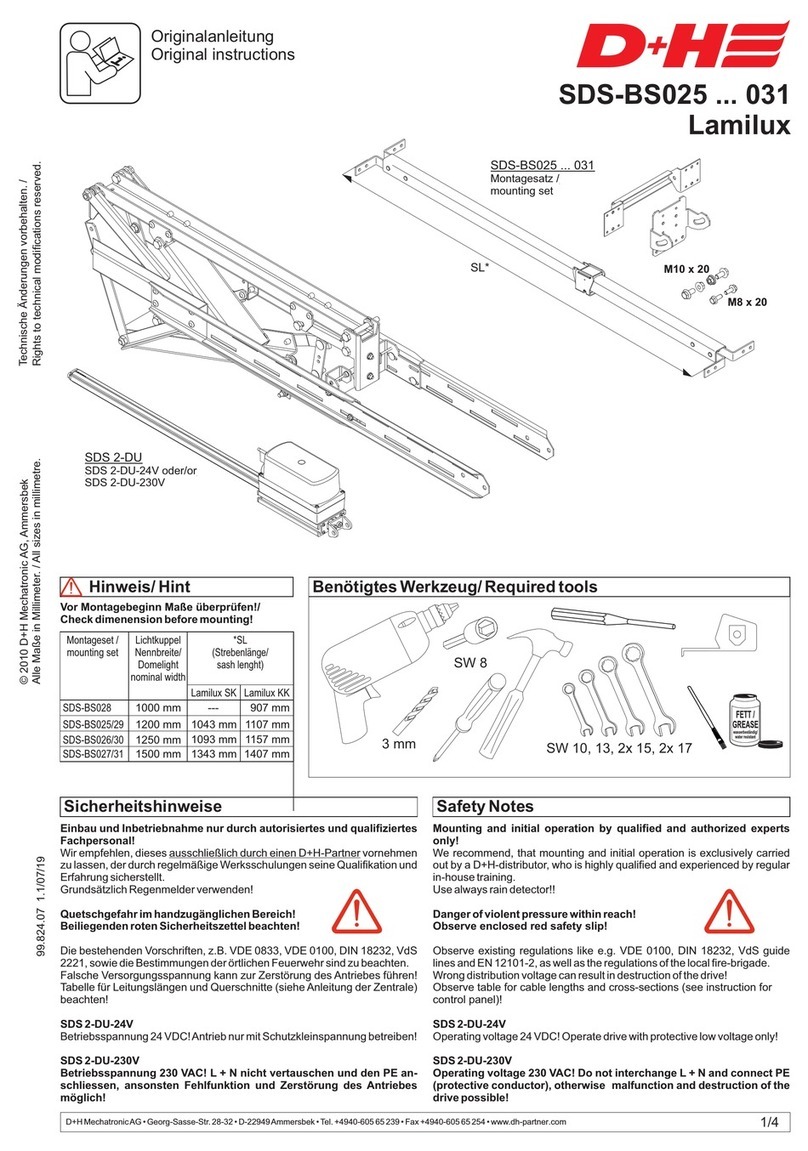
D+H
D+H Lamilux SDS-BS025 031 Series Original instructions
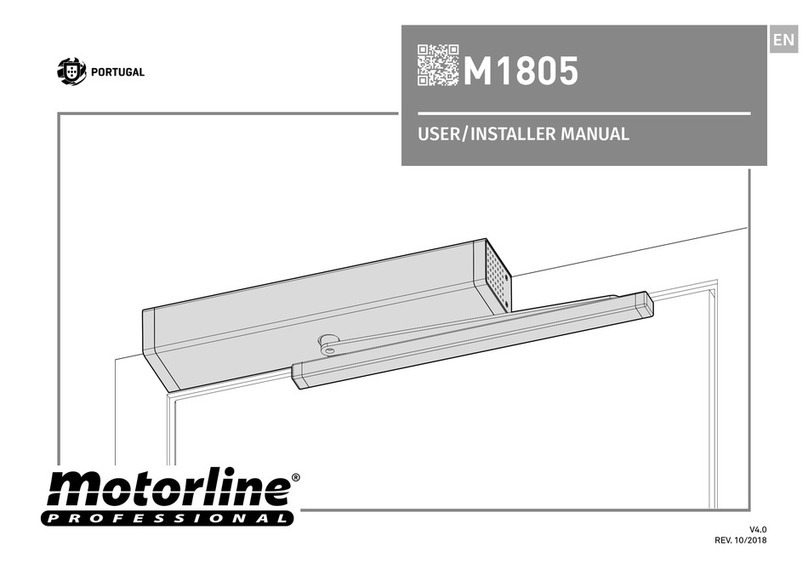
Motorline professional
Motorline professional M1805 User& installer's manual
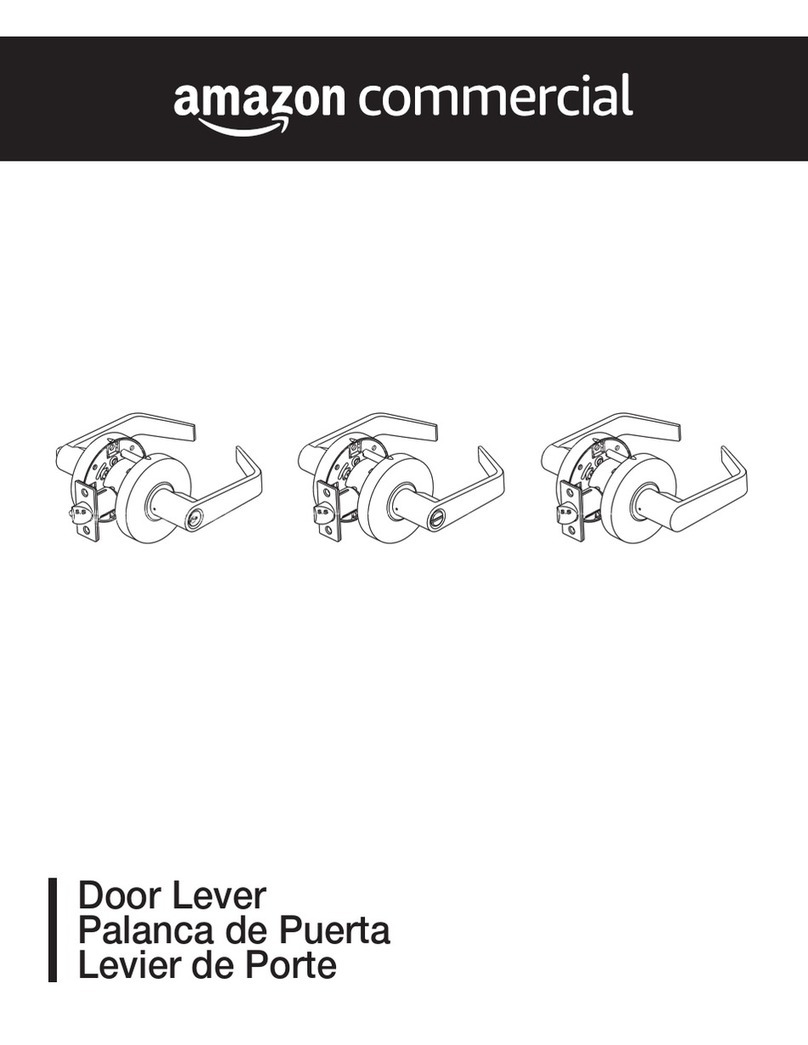
AMAZON COMMERCIAL
AMAZON COMMERCIAL Entry B07RV879LT Welcome guide
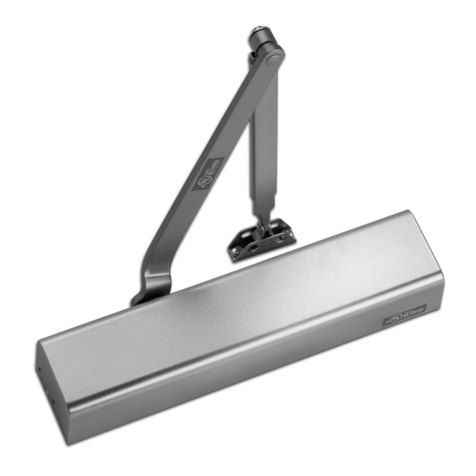
PDQ
PDQ 5300 Instruction
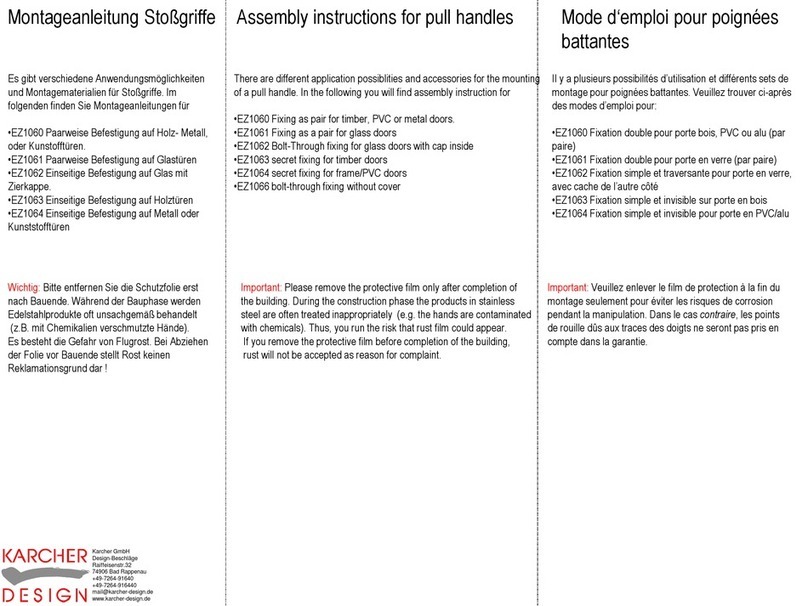
Karcher Design
Karcher Design EZ1060 Assembly instruction
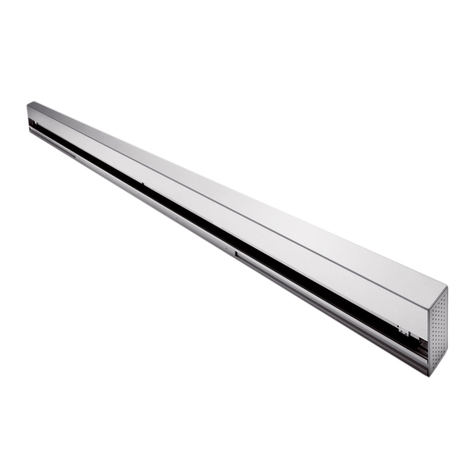
Dorma
Dorma ES 200 Easy Mounting instruction


